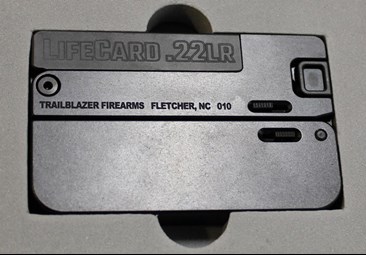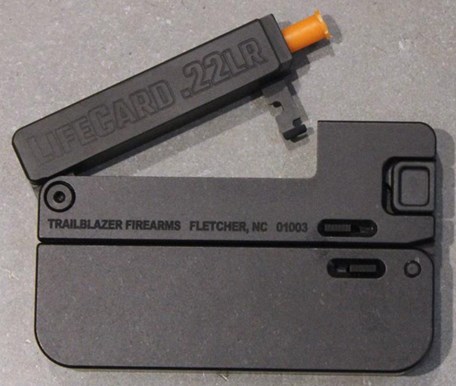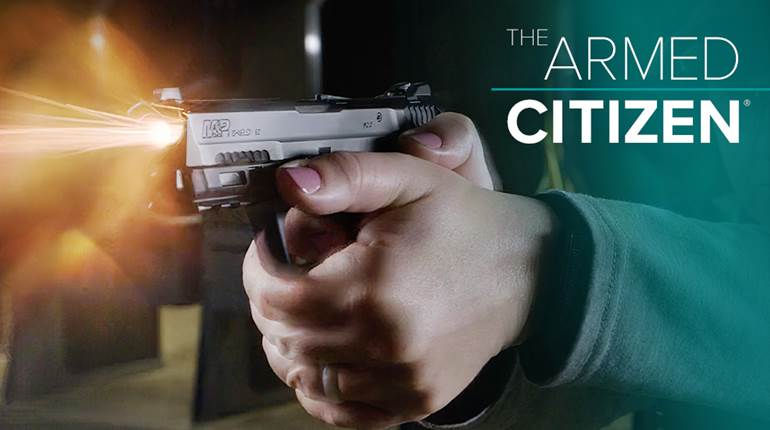
One of the reasons I enjoy participating in the shooting sports is the rich diversity of firearms to choose from on the American market. Nevertheless, we don't often get to see truly new models that are significantly different or innovative. Fine guns are readily available in droves, but fresh ideas, not so much. This is why I was on the phone placing a request for the new American-made Trailblazer Firearms LifeCard .22 within moments of reading the press release that went out in August 2017. I hadn't seen anything quite like it before.
More than seven years in development, the LifeCard .22 is a slim, single-shot rimfire pistol which folds up for easy carry. This gun's folded profile and thickness is comparable to a stack of credit cards. You can almost hide it under a standard 50-round box of .22 ammunition. Consisting of just 27 components, its snag-free design allows it to comfortably slip into a pants or purse pocket like a small wallet or coin purse. It has a listed weight of 7 oz. but the unit I worked with tipped the scale at 6.6 oz.

My very first question when I met with Aaron Voigt, Founder of Trailblazer Firearms and designer of the LifeCard, was how the pistol eluded a National Firearms Act (NFA) Any Other Weapon (AOW) classification? AOW weapons include firearms designed to look like ordinary objects such as pens, walking sticks or umbrellas. They require the same kind of paperwork and fees as machine guns and sound suppressors.

 The LifeCard does not qualify as an AOW because it cannot fire when the grip is folded. The trigger is captured in a small pocket inside the grip and the trigger in turn captures the hammer to prevent it from being cocked. The pistol must be opened all the way with the barrel locked into the open position with the trigger completely exposed in order to fire. This makes its appearance and operation similar enough to a typical handgun to qualify for sale without the additional tax stamps.
The LifeCard does not qualify as an AOW because it cannot fire when the grip is folded. The trigger is captured in a small pocket inside the grip and the trigger in turn captures the hammer to prevent it from being cocked. The pistol must be opened all the way with the barrel locked into the open position with the trigger completely exposed in order to fire. This makes its appearance and operation similar enough to a typical handgun to qualify for sale without the additional tax stamps.
The .22 Long Rifle barrel liner is milled from billet 4140 steel, button rifled and treated with a matte black Isonite Finish. The hammer, single-action trigger, barrel release and grip release are also 4140 steel. The tilting barrel shroud and frame are composed of milled light-weight 6061 aluminum components which receive a durable hard-coat anodized finish.
The sighting system consists of a rudimentary V-Notch groove that runs the length of the barrel. It preserve's the gun's sleek outline but doesn’t provide much to work with at the shooting range. A small gap between the barrel and the top of the receiver exposes a portion of the cartridge rim so as to act as a loaded chamber indicator.

The single-shot barrel is opened by pulling the frame mounted barrel release, located between the barrel and hammer, back towards the hammer. Spent shell casings are extracted from the chamber using a fingernail. The barrel release must be held back in the open position in order for the barrel to close. The barrel can be opened and closed with the grip folded, but it will not open or close if the hammer is cocked.

The hammer has a milled-in firing pin and three positions: forward, half-cocked and fully cocked. It must be manually placed in the fully cocked position for each shot. This is easily accomplished by pulling back on the hammer's square grasping tab. When the pistol is fired, the hammer rests in the forward position with the firing pin pressed against the rim of the cartridge.

A gentle tug places the hammer in the half-cocked position which is used for most administrative purposes including loading, unloading, folding the grip, and concealed carry. The grip will not fold completely closed unless the hammer is in the half-cocked position. The extension at the top of the hammer has a hole drilled through it. The hasp of the small padlock provided with the pistol fits though this hole to prevent unauthorized operation of the gun.

The grip release is pressed towards the heel of the grip (away from the hinge) to release it from the folded position. The barrel swings loose until pressed up into the locked position. In the course of testing, I handed the LifeCard to at least a half-dozen other people who all agreed that the grip was surprisingly comfortable to hold and, despite the pistol's diminutive size, the grip provides plenty of room to form a proper three-finger grip.

 The grip frame is hollow in order to accommodate the narrow steel trigger. A portion of the grip space has been made into a storage compartment that will hold up to four .22 LR cartridges. The slip cover for the ammo compartment is secured by a tiny, AR-like spring and detent that will go sailing into space if you pull the cover all the way out of the grip. I don't see this design choice as a deal breaker since the cover is not critical to the pistol's reliable operation. However, a no-searching-required means of securing the cover would be an improvement worth considering for future models.
The grip frame is hollow in order to accommodate the narrow steel trigger. A portion of the grip space has been made into a storage compartment that will hold up to four .22 LR cartridges. The slip cover for the ammo compartment is secured by a tiny, AR-like spring and detent that will go sailing into space if you pull the cover all the way out of the grip. I don't see this design choice as a deal breaker since the cover is not critical to the pistol's reliable operation. However, a no-searching-required means of securing the cover would be an improvement worth considering for future models.
One of the key features of a brand new or unusual gun that will determine its acceptance or rejection by the shooting public is the trigger pull. For some reason a goodly number of pocket pistols leave the factory with so-so or overly heavy triggers. This is not the case with the LifeCard. With a protective polymer snap-cap in place to protect the hammer pin (this gun should not be dry fired without one), the same folks who liked the shape of the grip were surprised by the quality of the single-action trigger. It's smooth with a clean break and a short stroke. It broke with just 3 lbs. 1 oz. of trigger pull according to a Lyman's digital trigger gauge.
The overall fit and finish of the Trailbazer LifeCard was excellent. The gun exudes a sense of quality from top to bottom and it has a solid heft to it. The finishes are evenly applied with the machined components properly joined. All of the controls operated as advertised and the trigger was enjoyable to work with. Recoil was, of course, mild and easy to control.

To test this pistol as an always-on-hand carry piece, I used my jeans watch pocket (the small pocket inside the right front pocket most folks use for spare change). This gave it a dedicated pocket while leaving the other pockets free for other daily carry items. With its slim, flat profile it simply disappeared in there.

With a bit of practice, I found that I could draw the pistol from the watch pocket, release the folded grip, lock the barrel into firing position, cock the hammer and fire the single loaded cartridge into a target in just under four seconds. This same drill with a reload, for a total of two shots fired, took just under 10 seconds when I held the second cartridge in my support hand at the start of the drill. These times are relatively slow by conventional self-defense standards. However, the deployment speeds were not nearly as slow as I thought they might be before working with the gun.
The LifeCard proved to be reliable with a variety of .22 Long Rifle loads ranging from bulk-box practice rounds up to premium hunting loads produced by most of the big players including Aguila Ammunition, Browning Ammunition, CCI Ammunition, Federal Premium, Remington and Winchester. I had a single failure to fire with a bulk-box round due to a faulty primer. When I rotated the cartridge and struck it again it went off. Every other shot fed, fired and extracted without a hitch.

This is an ideal gun to have along for close-range pest control, so I loaded it up with CCI .22 Shotshells topped with about 165 pellets of #12 lead birdshot (1/15 oz.) to see how it would pattern. The tiny lead pieces of birdshot spread very quickly to form a 7" pattern at 1.5 yards and a 13" pattern at 3 yards.
Formal accuracy testing was conducted from a bench rest at 7 yards. I believe the pistol has better accuracy potential than I was able to squeeze out of it using the simple V-Notch groove sight. Group sizes varied significantly during informal and formal testing at this distance (1.25" to 3.5") depending on the brand and bullet weight fired. So you may have to test a few loads to find the best fit.

Aguila Interceptor 40-gr. copper-plated flat points turned in a best single group of 1.31" with an average of 1.38". Browning BPR 37-gr. fragmenting copper-plated hollow points printed a best group of 2.28" with an average of 2.41". Federal Premium 40-gr. Hunter Match lead hollow points yielded a best group of 1.44" with an average of 1.51".

It's a tremendous challenge both technically and bureaucratically to bring a new handgun to the market these days, especially when it's as unique as the Trailblazer LifeCard .22. This folding pistol is precision crafted, fun to shoot and has a cool factor that's off the charts. The company says the LifeCard will be the last gun you’ll leave behind. It’s hard to disagree with that assessment. It's a kit gun that's just too slim, light and easy to pack around to leave it at home. Being able to tuck four extra rounds into the grip makes it a handy, self contained system.

Tuck the LifeCard into a pants pocket, purse, backpack, tackle box, automotive console or bug-out bag. It's an ideal trail and fishing gun to have along in case you run into aggressive poisonous snakes or vermin. Trailblazer Firearms will be offering protective leather holster pouches for the LifeCard soon in black and tan versions (prices and availability have yet to be announced). I’m looking forward to seeing what this company comes up with next.

Specifications:
Manufacturer: Trailblazer Firearms
Model: LifeCard .22
Action: Tilt Barrel Single-Action
Caliber: .22 Long Rifle
Barrel: Milled Billet 4140 Steel, Button Rifled, Isonite Finish
Frame: Milled Billet 6061 Aluminum, Hard-Coat Anodized Aluminum
Sights: V Groove
Barrel Length: 2.5”
Folded Dimensions: Length 3.375", Height 2.125", Thickness 0.5"
Weight: 6.6 oz., Unloaded
Trigger Pull: 3 lbs. 1 oz. (As Tested)
Capacity: 1 Round
Ammunition Storage: 4 rounds
Twist: 1:16” RH
Rifle Grooves: 6
Accessories: Lock, Owner's Manual
MSRP: $399





































